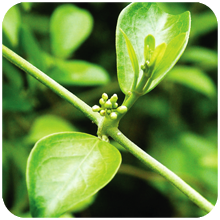
Gymnema sylvestre is a slow growing, perennial, woody climber, distributed throughout the India, in dry forests upto 600 m height. It is mainly present in the tropical forest of Central and Southern India. The plant is a large, more or less pubescent woody climber. The leaves are opposite, usually elliptic or ovate (1.25 – 2.0 inch x 0.5-1.25 inch). Flowers are small, yellow, in axillary and lateral umbel in cymes; Follicles are terete and lanceolate upto 3 inches in length. The Calyx-lobes are long, ovate, obtuse and pubescent. Corolla is pale yellow campanulate, valvate, corona single, with 5 fleshy scales.
Chemical composition – The most important components of the plant are Gymnemic acids and saponins belonging to oleanane type saponins and, gymnemaside are dammarane saponins. Other components include anthraquinones, flavones, hentriacontane, pentatriacontane, phytin, resins, tartaric acid, formic acid, butyric acid, Lupeol-related glycosides, β-amyrin, stigmasterol, and calcium oxalate. G. sylvestre leaves contain glycosides and anthraquinones acids and their derivatives. Major secondary metabolites of Gymnema include a new group of related acidic glycosides, gymnemic acid. Also contains Gurmarin A, an important 35 amino acid peptide.
Properties – Anti-inflammatory, anodyne, digestive, liver tonic, diuretic, thermogenic, stomachic, stimulant, anthelmintic, laxative, cardiotonic, expectorant, antipyretic and uterine tonic, antipyretic, astringent, a alexipharmic, cardiotonic, hypolipidemic.
* Antidiabetic action – Supports insulin secretion, promotes regeneration of pancreatic cells, supports the proper utilization of glucose in the body and causes inhibition of glucose absorption from the intestine.
Recommendation – Diabetes, gastric disorders, obesity, hyperlipidemia, constipation, fluid retention, liver problems, blood pressure, tachycardia, arrhythmias, asthma, cough, skin problems, heart disease, conjunctivitis, dyspepsia, hemorrhoids, hepato-splenomegaly, inflammations, intermittent fever, jaundice and leucoderma.
This plant is incorporated in natural remedy DAITAB.




